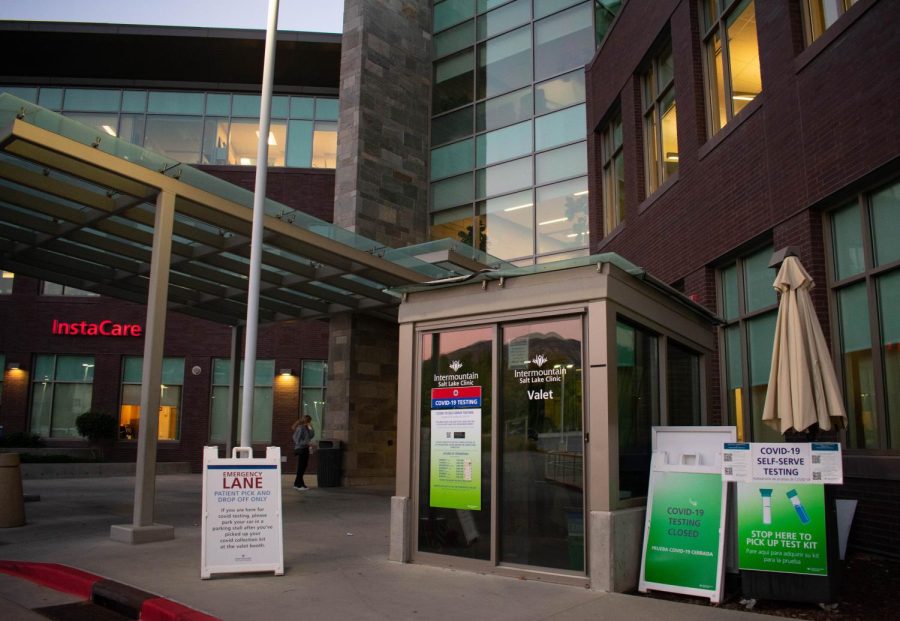Mendenhall: Let Healthcare Facilities Choose Their Post-Pandemic Protocols
The Intermountain Healthcare Clinic in Salt Lake City on Oct. 4, 2022. (Photo by Andrea Oltra | The Daily Utah Chronicle)
October 6, 2022
The COVID-19 pandemic introduced new challenges to nearly every area of our lives. The healthcare industry, in particular, suffered the most. Many changes were enforced to ensure safety out of necessity. Some of the changes introduced in 2020 included mask-wearing, social distancing — sometimes through marks on flooring — and telehealth doctor visits. Now, as we approach year three of the pandemic, we’ve seen many hospitals and clinics adopt these changes into their normal, everyday routines. Some facilities might not need to have as strict levels of protocol implemented, but that is only for them to decide. We must permit different medical facilities to determine necessary protocol implementation on an individual basis.
Pre and Post-Pandemic Policies
Prior to the pandemic, hospitals still adhered to intense sanitation and disinfection protocols. However, the pandemic demanded a massive overhaul of safety measures to discourage the spread of the coronavirus, but also to protect patients and employees alike. Physical changes included masking, social distancing and an increase in ventilating indoor spaces. Other changes the healthcare industry experienced were reducing elective procedures and leaning on telehealth doctor’s appointments. Telehealth appointments proved beneficial in some cases but were detrimental in others. It was hard for clinicians to provide adequate care over the phone, and it also made patients question their HIPAA privacy and safety.
Two and a half years later, it’s intriguing to look back and see which “improved” safety precautions have become second nature in facilities like hospitals, clinics and surgical centers. Every hospital that I’ve been to recently has still required mask wearing, no matter what kind of appointment. The clinic I work in will ask patients to fill out a COVID-19 exposure consent form and check their temperature prior to surgery. We also have plexiglass barriers at the front desk to protect workers from patients getting too close. Masks are no longer required, but about half of our patients and staff members still prefer to wear them. Those that do choose to still wear masks are unfortunately being questioned as to why. We’ve dealt with a lot more employee abuse that has accompanied COVID-19 restrictions. This doesn’t pair well with the fact that healthcare workers are already often chronically overworked.
Pre and Post-Pandemic Treatment of Workers
Before the pandemic, healthcare workers did not report levels of dissatisfaction with their jobs as often as they do now. Problems certainly existed, but those were severely exacerbated once the pandemic began in 2020. According to the National Library of Medicine, “The COVID-19 pandemic has put excessive pressure on frontline HCWs and hospitals.” This is due to a stressful workload, psychological distress, the novelty and unpredictability of the virus itself and shortages of vital personal protective equipment throughout the country, just to name a few reasons.
Elsevier Health recently published a report on the foreseeable future of healthcare. The survey states that 47% of healthcare workers in the U.S. are planning to leave their jobs sometime in the next few years. Given the way that healthcare workers are standing up for how they are treated in the workplace, this number shouldn’t be too surprising. I have several family members that work in healthcare that have either switched companies for better treatment and benefits or have decided to quit or retire altogether.
Healthcare Worker’s Experiences
It’s important to remember that each healthcare worker has their own story to tell. I’ve learned that just because I have experience working in healthcare, it doesn’t mean that another healthcare worker will have the same things to say as me. Many front-line workers experience severe burnout, anxiety and stress throughout the workday. However, to Weber State University student and University of Utah Hospital CNA Kit Talbot, these mental and physical tolls are completely worth it to keep her patients safe.
Talbot began working in healthcare about three to five months before the pandemic really hit Utah. She worked in a nursing home with high-risk individuals at the time, stating that because her workplace had such strict adherence to COVID-19 guidelines, “we postponed having it in our facility for months.” Her workplace enforced wearing N95 masks underneath a regular surgical mask, getting tested twice a week and wearing protective cloth gowns over their clothes. Talbot shared, “… it was hard on us, but I definitely think it was worth it, getting tested twice a week and wearing all of this personal protection equipment.”
Some medical facilities do not treat such high-risk demographics. It’s not worth it to subject each healthcare facility to the same guidelines, especially since it’s done more harm than good to employees. Some healthcare workers accept it as part of their jobs, but others can’t do the same. They may not just struggle directly with mental health, but also with the more physical risks that come with working in healthcare. These again include but are not limited to exposing loved ones to possible infection, lack of personal protective equipment (PPE), long shifts with minimal rest and being chronically short-staffed due to workplace breakouts of COVID-19.
Some pandemic-era changes are here for good, whether we like them or not. Whether it’s a matter of convenience or necessity, how to move forward can only be decided by individual facilities. Our world is ever changing, and as a community and individuals, we will have to decide what’s best for us.














Treven • Nov 10, 2022 at 3:59 pm
Try telling this to my friend with MS who literally can’t go anywhere without a mask because if they did they have a very very high risk of dying. Masking guidelines are a minor inconvenience that are better that risking someone else’s life for the sake of mental health. Not to mention the long covid risks associated with being the largest mass disabling event in history. We need standardized covid guidelines in healthcare regardless of inconvenience to the average able bodied person.